The mystery of the spiral staircase
Miracle or mystery?

The Loretto Chapel in Santa Fe attracts 250,000 visitors a year to view its famous spiral staircase. The chapel is now a museum owned by a private company and hosts stylish weddings. If the story of the spiral staircase sounds familiar, it has appeared on the TV show Unsolved Mysteries as well as a CBS movie entitled The Staircase (1998).
The chapel was built between 1873 and 1878, is Gothic Revival in style and is patterned after the Louis IX Sainte Chapelle in Paris. The Sisters of Loretto (light) had established a girls’ school in 1852 and wanted a chapel, so they raised $30,000 and hired French architect Antoine Mouly. The first contractor was Projectus Mouly, son of the architect. Projectus died of either pneumonia or a gunshot from an angry husband, leaving the nuns with an unfinished church. The church needed a stairway to the rear choir loft and someone to build it.
The mystery
The architectural problem was how to reach the loft with a staircase that would not reduce the number of seats in the chapel. The nuns prayed to Joseph, patron saint of carpenters. Soon a stranger with a toolbox arrived, looking for work. Over the next six months, this mysterious man built a stairway that was both functional and beautiful.
The completed spiral stairway is 23 and half feet high and has 33 steps. The entire weight rests on its base and it should have toppled over years ago, according to the laws of gravity. There is no central column for support. The carpenter used no nails, screws, metal plates or glue, preferring to use wooden pegs or dowels to hold the entire staircase together. He worked alone and the nuns only saw wood being soaked in hot water. When the staircase was finished, the carpenter disappeared without collecting his wages. The nuns concluded that the carpenter could have been Saint Joseph himself and that they had witnessed a miracle.
Mystery solved
Historical research has disclosed that the carpenter was likely Francois-Jean ‘Frenchy’ Rochas, a recent arrival from France. The spiral staircase was not new in French churches, but certainly was new in Santa Fe, a remote area of the United States.
It is not a miracle that keeps the staircase in place, either. Engineers explain that the staircase is so narrow that the stringers or beams on either side of the steps act as one vertical support beam, transferring the weight to the base. The proper technical term is double helix, meaning a line that rises as it twists like a screw—an accurate description of the staircase. The stairs make two 360-degree turns, with the top stair attached to the floor of the loft.
The nuns complained that the stairs bounced or moved and they were afraid to use them. Ten years later another carpenter, Phillip August Hesch, added railings for safety. For more information see the books Helix to Heaven by Joe Nickell (1998) and Loretto: The Sisters and Their Santa Fe Chapel (2002) by Mary Jean Straw Cook.
The staircase is a work of superior craftsmanship that was used for over 100 years. In the interest of safety, the staircase has not been used on a regular basis since the 1970s. For greater stability, a support now attaches the staircase to an adjacent pillar.
One mystery still remains. The wood in the staircase is a hard spruce that has both strength and flexibility. Spruce is not indigenous to New Mexico and had to be imported. The nuns have never found any written records of spruce being imported—or what happened to their carpenter.






